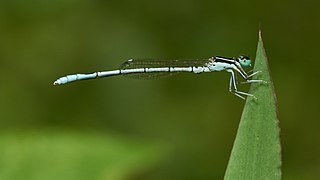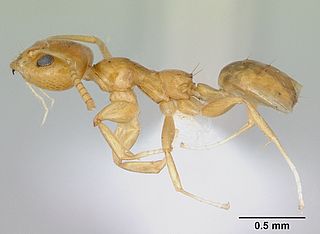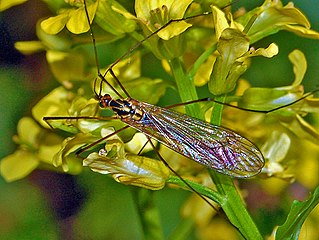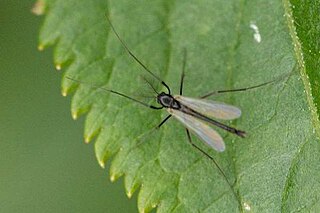 W
WAcanthomyrmex dusun is a species of ant that belongs to the genus Acanthomyrmex. It was described by Wheeler in 1919, and is found in Indonesia.
 W
WAciagrion occidentale, green striped slender dartlet, is a species of damselfly in the family Coenagrionidae. It is found in India, Sri Lanka, Maldives, Vietnam and Thailand.
 W
WAgriocnemis pieris, white dartlet, is a species of damselfly in the family Coenagrionidae. It is found in India and is likely to extend into Bangladesh.
 W
WAgriocnemis splendidissima, the splendid dartlet, is a species of damselfly in the family Coenagrionidae. It is distributed throughout India and Pakistan and may be present in Bangladesh as well.
 W
WAxinidris hypoclinoides is a species of ant in the genus Axinidris. Described by Santschi in 1919, collected specimens are only known to be from forestry regions in several African countries.
 W
WCrematogaster atkinsoni is a species of ant in tribe Crematogastrini. It was described by Wheeler in 1919.
 W
WCrematogaster californica is a species of ant in tribe Crematogastrini. It was described by Wheeler in 1919.
 W
WDrosophila simulans is a species of fly closely related to D. melanogaster, belonging to the same melanogaster species subgroup. Its closest relatives are D. mauritiana and D. sechellia.
 W
WEctatomma opaciventre is a South American species of ant from the subfamily Ectatomminae. In the Brazilian savannah, nests occur at low density and in specific microhabitats.
 W
WEnallagma vesperum, the vesper bluet, is a species of narrow-winged damselfly in the family Coenagrionidae. It is found in North America.
 W
WExoprosopa jonesi is a species of bee flies in the family Bombyliidae.
 W
WHomalictus is a subgenus of bees in the genus Lasioglossum subfamily Halictinae of the family Halictidae. They are found in Sri Lanka, Southeast Asia, east across the Pacific to the Mariana Islands, Samoa and are most prevalent in Australia.
 W
WLaphria ithypyga is a species of robber flies in the family Asilidae.
 W
WThe Lestoideidae are a family of damselflies occurring in South-east Asia, New Guinea and Australia. The family comprises two genera and nine species.
 W
WLyriothemis tricolor is a species of dragonfly in the family Libellulidae. It is found in Bangladesh, China, India, Japan, Myanmar, and Taiwan.
 W
WMyrmica vandeli is an ant species found sporadically across several European countries. It often coexists with M. scabrinodis. It lives in open, wet meadows. Nests are typically constructed in moss pads. Polygynous colonies may contain 1500 workers. Larvae of Phengaris butterflies may parasitize their colonies.
 W
WNephrotoma appendiculata, the spotted crane fly, is a species of crane fly.
 W
WNotiothemis jonesi, eastern forestwatcher, Jones’ forestwatcher or eastern elf, is a species of dragonfly in the family Libellulidae. It is found from South Africa to Kenya, Uganda, Malawi and Zambia. Its natural habitats include pools and swamps in subtropical or tropical forests; absent from lowlands.
 W
WOphiderma definita is a species of treehopper in the family Membracidae. They can be found between March and June in the Central and Eastern regions of the United States and Canada.
 W
WParatendipes albimanus is a species of midge in the family Chironomidae. It is found in Europe.
 W
WPhania speculifrons is a species of fly in the family Tachinidae.
 W
WPlatymeris laevicollis is a venomous predatory true bug from central Africa that can be found in forests, scrublands, grasslands, and croplands. They are efficient predators and are used by farmers on coconut plantations to control herbivorous pests such as the rhinoceros beetle. As a true bug of the order Hemiptera, it has needle-like mouth parts designed for sucking juices out of plants or other insects instead of chewing. P. laevicollis has sharp stylets in its proboscis or rostrum used to pierce the exoskeleton of its prey. Saliva is then injected into the prey which liquifies its tissues,and the rostrum is then used to suck out the digested fluids. If disturbed, it is capable of a defensive bite considered to be more painful than a bee sting.
 W
WPtychoptera minuta is a species of fly in the family Ptychopteridae. It is found in the Palearctic.
 W
WThe chilli thrips or yellow tea thrips, Scirtothrips dorsalis Hood, is an extremely successful invasive species of pest-thrips which has expanded rapidly from Asia over the last twenty years, and is gradually achieving a global distribution. It has most recently been reported in St. Vincent (2004) Florida (2005), Texas (2006), and Puerto Rico (2007). It is a pest of economic significance with a broad host range, with prominent pest reports on crops including pepper, mango, citrus, strawberry, grapes, cotton, tea, peanuts, blueberry, and roses. Chilli thrips appear to feed preferentially on new growth, and infested plants usually develop characteristic wrinkled leaves, with distinctive brown scarring along the veins of leaves, the buds of flowers, and the calyx of fruit. Feeding damage can reduce the sale value of crops produced, and in sufficient numbers, kill plants already aggravated by environmental stress. This thrips has also been implicated in the transmission of three tospoviruses, but there is some controversy over its efficiency as a vector.
 W
WTurneria pacifica is a species of ant in the genus Turneria. Described by William M. Mann in 1919, the species is endemic to the Solomon Islands and Vanuatu.